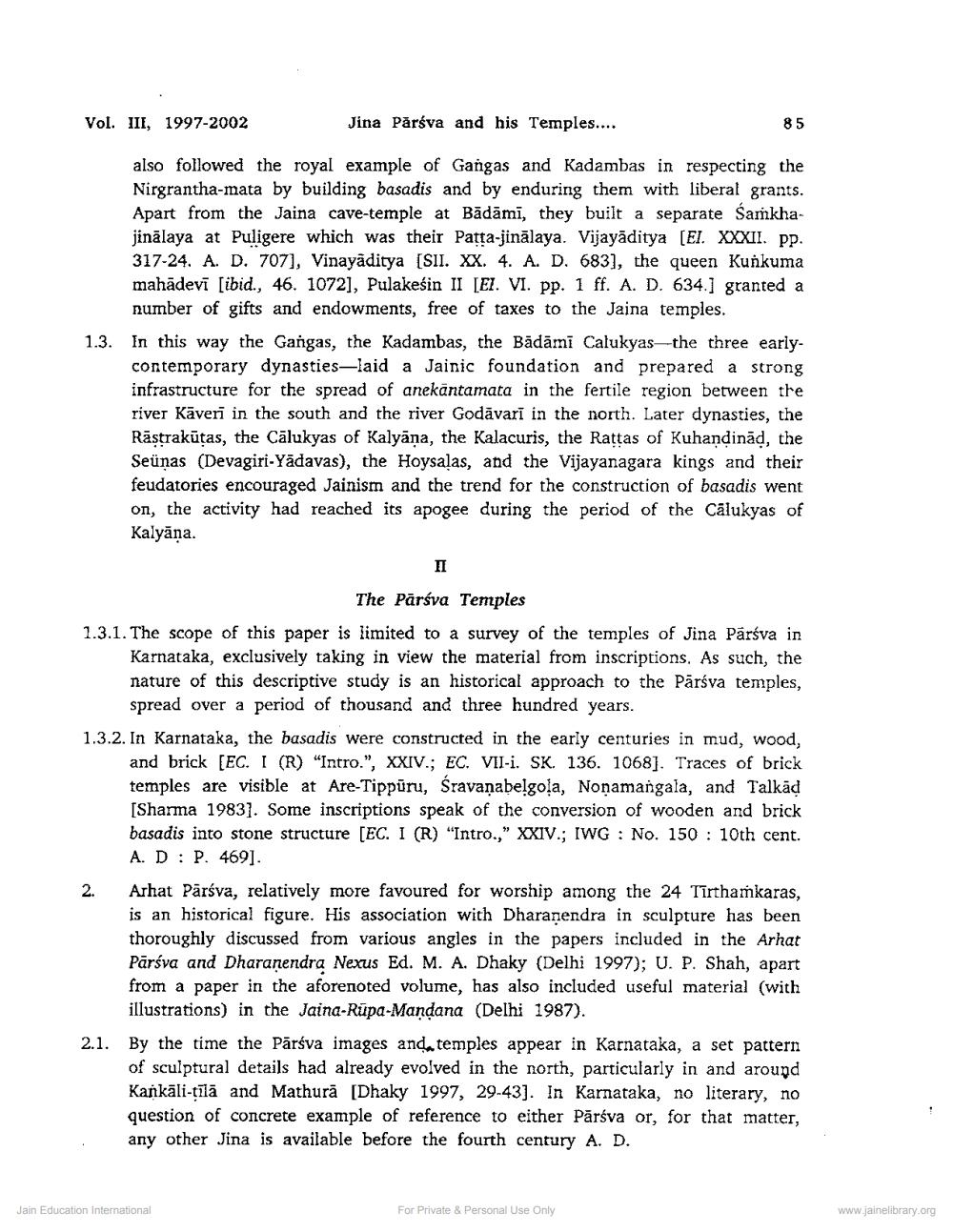Book Title: Jin Parsva and His Temples in Inscriptions of Karnataka Author(s): Hampa Nagrajaiha Publisher: Z_Nirgrantha_1_022701.pdf and Nirgrantha_2_022702.pdf and Nirgrantha_3_022703.pdf View full book textPage 2
________________ Vol. III, 1997-2002 Jina Părśva and his Temples.... 85 also followed the royal example of Gangas and Kadambas in respecting the Nirgrantha-mata by building basadis and by enduring them with liberal grants. Apart from the Jaina cave-temple at Bādāmī, they built a separate Samkhajinālaya at Puligere which was their Patta-jinālaya. Vijayāditya (EI. XXXII. pp. 317-24. A. D. 707], Vinayāditya [SII. XX. 4. A. D. 683), the queen Kunkuma mahādevi (ibid., 46. 1072], Pulakesin II [EI. VI. pp. 1 ff. A. D. 634.] granted a number of gifts and endowments, free of taxes to the Jaina temples. 1.3. In this way the Gangas, the Kadambas, the Bādāmī Calukyas--the three early contemporary dynasties-laid a Jainic foundation and prepared a strong infrastructure for the spread of anekantamata in the fertile region between the river Kāverī in the south and the river Godāvarī in the north. Later dynasties, the Rāstrakūtas, the Cālukyas of Kalyāna, the Kalacuris, the Rattas of Kuhandināà, the Seünas (Devagiri-Yadavas), the Hoysalas, and the Vijayanagara kings and their feudatories encouraged Jainism and the trend for the construction of basadis went on, the activity had reached its apogee during the period of the Cālukyas of Kalyāna. The Pāríva Temples 1.3.1. The scope of this paper is limited to a survey of the temples of Jina Parśva in Karnataka, exclusively taking in view the material from inscriptions. As such, the nature of this descriptive study is an historical approach to the Pārśva temples, spread over a period of thousand and three hundred years. 1.3.2. In Karnataka, the basadis were constructed in the early centuries in mud, wood, and brick (EC. I (R) "Intro.", XXIV.; EC. VII-I. SK. 136. 1068]. Traces of brick temples are visible at Are-Tippūru, Sravanabelgola, Nonamangala, and Talkād [Sharma 1983]. Some inscriptions speak of the conversion of wooden and brick basadis into stone structure [EC. I (R) "Intro.," XXIV.; IWG : No. 150 : 10th cent. A. D: P. 469]. Arhat Pārsva, relatively more favoured for worship among the 24 Tīrthamkaras, is an historical figure. His association with Dharanendra in sculpture has been thoroughly discussed from various angles in the papers included in the Arhat Pārsva and Dharanendra Nexus Ed. M. A. Dhaky (Delhi 1997); U. P. Shah, apart from a paper in the aforenoted volume, has also included useful material (with illustrations) in the Jaina-Rūpa-Mandana (Delhi 1987). By the time the Pārsva images and temples appear in Karnataka, a set pattern of sculptural details had already evolved in the north, particularly in and around Kankāli-tilä and Mathurā [Dhaky 1997, 29-43]. in Karnataka, no literary, no question of concrete example of reference to either Pārsva or, for that matter, any other Jina is available before the fourth century A. D. 2.1. Jain Education International For Private & Personal Use Only www.jainelibrary.orgPage Navigation
1 2 3 4 5 6 7 8 9 10 11 12 13 14 15 16 17 18 19 20 21 22 23
